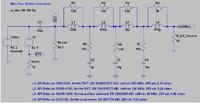chandregowda
Full Member level 4
- Joined
- Jul 7, 2008
- Messages
- 212
- Helped
- 14
- Reputation
- 28
- Reaction score
- 4
- Trophy points
- 1,298
- Location
- Bengaluru/Bangalore, India
- Activity points
- 2,564
bias tee circuit
hi,
can any body suggest me how to design a bias tee that works for GSM 1800MHz,
(Frequency range 0.1MHz to 1800MHz).
suggest if any book/link/papers
thanks in advance
hi,
can any body suggest me how to design a bias tee that works for GSM 1800MHz,
(Frequency range 0.1MHz to 1800MHz).
suggest if any book/link/papers
thanks in advance
